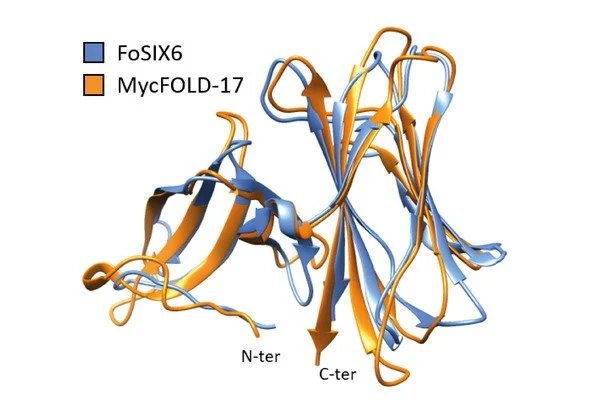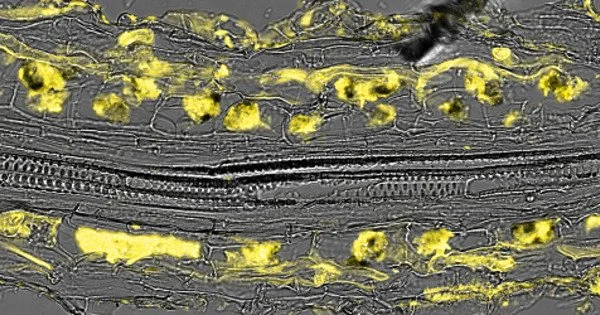Fungi have evolved intricate mechanisms to interact with plants, either forming mutually beneficial associations or causing diseases. In both cases, fungi can manipulate plant physiology and form close relationships with their hosts.
Symbiotic and pathogenic fungi that interact with plants are distantly related and share few genetic similarities. Scientists at Sainsbury Laboratory Cambridge University (SLCU) discovered that plant pathogenic fungi and plant symbiotic fungi use a similar set of proteins to manipulate and live within plants.
Sebastian Schornack’s research team is looking for new arbuscular mycorrhiza (AM) effectors, which are proteins secreted by symbiotic AM fungi to help plant roots colonize. They are also looking into whether pathogenic and symbiotic fungi use similar or different strategies.
The team is the first to compare secreted proteins from symbiotic and pathogenic fungi using the AlphaFold2 AI computer program that predicts protein structures. They discovered that symbiotic fungi encode the same protein family used by pathogenic fungi to interact with and colonize plants. The findings were published in the journal New Phytologist.
We used the recently developed AlphaFold2 to compare the secreted protein structures of a symbiotic fungus and a pathogenic fungus. This led to the discovery of a group of structurally very similar proteins previously known from pathogens that are also encoded in the genomes of symbiotic fungi, often in greater numbers.
Dr. Albin Teulet
“Because the genetic code of effector proteins in closely related microbes is so diverse, comparing protein sequences between pathogens and symbionts that are more distantly related is even more difficult,” said Dr. Albin Teulet, the study’s first author. “Instead, we used the recently developed AlphaFold2 to compare the secreted protein structures of a symbiotic fungus and a pathogenic fungus. This led to the discovery of a group of structurally very similar proteins previously known from pathogens that are also encoded in the genomes of symbiotic fungi, often in greater numbers.”
Plant-fungi interactions have a significant impact on plant health in natural ecosystems and agriculture, both positively and negatively. AM fungi are the most common plant-microbe symbiotic association, colonizing plant roots to promote nutrient uptake, plant growth, and even pathogen defense. While pathogenic fungi, such as Fusarium oxysporum strains, are some of the world’s most lethal pathogens with a diverse host range and are currently threatening to wipe out Cavendish banana and oil palm plantations. Fusarium has also given its name to the group of proteins discovered by the team: Fusarium oxysporum lycopersici dual-domain proteins (FOLDs).
The researchers classified all the proteins secreted by the symbiotic AM fungus Rhizophagus irregularis and identified a large family of FOLD-like effectors (MycFOLDs) with high structural similarity to the FOLD proteins produced by the Fusarium oxysporum pathogen.

Only fungi that form associations with living plants have FOLD effectors in their genomes. This suggests that these proteins are the foundation of universal mechanisms that allow pathogens and symbiotic fungi to coexist within plants.
The discovery that plants symbiotic and pathogenic fungi use some of the same tools, according to Dr. Schornack, provided a new perspective on our understanding of fungal symbionts: “The apparently exclusive presence of FOLD/MycFOLDs across unrelated plant-colonizing fungi supports the hypothesis that FOLD proteins act as effectors during plant colonization of both symbiotic and pathogenic fungi.”
“If symbiotic and pathogenic fungi are using the same tools, this means devising ways to enhance AM relationships in crops might make the crops more susceptible to pathogens at the same time. However, these findings now open new questions for us to explore, such as why do symbiotic fungi have these proteins that pathogens also have and what do they actually do?”
The fundamentals of plant-microbe interactions
Understanding the similarities and differences in the effectors used by symbionts and pathogens is critical to grasping the fundamentals of plant-microbe interactions. The plant-pathogen relationship has been extensively researched, and many of the effector proteins are already known. Plant-symbiont interactions, such as those between plants and AM fungi, are less well understood.
Plants that form beneficial relationships with symbiotic fungi have complete control over the colonization process; they can reject or expel colonizers if they believe the fungal colonization is unnecessary, such as in soil environments rich in nutrients like phosphate. However, because AM fungi rely on plant-produced nutrients, they have their own survival strategy, especially when the relationship is disliked by the plant.
Pathogenic fungi suppress their plant host’s immunity during infection by secreting a cocktail of effector proteins. Even though symbiotic fungi are beneficial to plants, they must communicate with the plant or overcome obstacles in order to colonize plant cells. Only a few effector proteins secreted by symbiotic AM fungi have been discovered. The Schornack Team is working to identify additional effectors involved in the plant-symbiont relationship.





